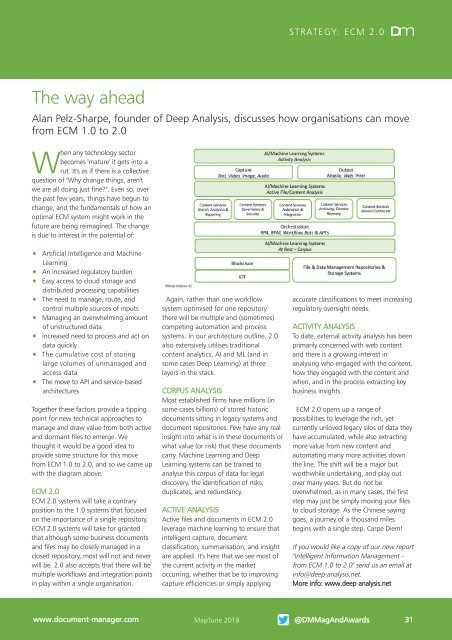You also want an ePaper? Increase the reach of your titles
YUMPU automatically turns print PDFs into web optimized ePapers that Google loves.
STRATEGY: ECM 2.0 Dm<br />
The way ahead<br />
Alan Pelz-Sharpe, founder of Deep Analysis, discusses how organisations can move<br />
from ECM 1.0 to 2.0<br />
When any technology sector<br />
becomes 'mature' it gets into a<br />
rut. It's as if there is a collective<br />
question of "Why change things, aren't<br />
we are all doing just fine?". Even so, over<br />
the past few years, things have begun to<br />
change, and the fundamentals of how an<br />
optimal ECM system might work in the<br />
future are being reimagined. The change<br />
is due to interest in the potential of:<br />
Artificial Intelligence and Machine<br />
Learning<br />
An increased regulatory burden<br />
Easy access to cloud storage and<br />
distributed processing capabilities<br />
The need to manage, route, and<br />
control multiple sources of inputs<br />
Managing an overwhelming amount<br />
of unstructured data<br />
Increased need to process and act on<br />
data quickly<br />
The cumulative cost of storing<br />
large volumes of unmanaged and<br />
access data<br />
The move to API and service-based<br />
architectures<br />
Together these factors provide a tipping<br />
point for new technical approaches to<br />
manage and draw value from both active<br />
and dormant files to emerge. We<br />
thought it would be a good idea to<br />
provide some structure for this move<br />
from ECM 1.0 to 2.0, and so we came up<br />
with the diagram above.<br />
ECM 2.0<br />
ECM 2.0 systems will take a contrary<br />
position to the 1.0 systems that focused<br />
on the importance of a single repository.<br />
ECM 2.0 systems will take for granted<br />
that although some business documents<br />
and files may be closely managed in a<br />
closed repository, most will not and never<br />
will be. 2.0 also accepts that there will be<br />
multiple workflows and integration points<br />
in play within a single organisation.<br />
Again, rather than one workflow<br />
system optimised for one repository<br />
there will be multiple and (sometimes)<br />
competing automation and process<br />
systems. In our architecture outline, 2.0<br />
also extensively utilises traditional<br />
content analytics, AI and ML (and in<br />
some cases Deep Learning) at three<br />
layers in the stack.<br />
CORPUS ANALYSIS<br />
Most established firms have millions (in<br />
some cases billions) of stored historic<br />
documents sitting in legacy systems and<br />
document repositories. Few have any real<br />
insight into what is in these documents or<br />
what value (or risk) that these documents<br />
carry. Machine Learning and Deep<br />
Learning systems can be trained to<br />
analyse this corpus of data for legal<br />
discovery, the identification of risks,<br />
duplicates, and redundancy.<br />
ACTIVE ANALYSIS<br />
Active files and documents in ECM 2.0<br />
leverage machine learning to ensure that<br />
intelligent capture, document<br />
classification, summarisation, and insight<br />
are applied. It's here that we see most of<br />
the current activity in the market<br />
occurring, whether that be to improving<br />
capture efficiencies or simply applying<br />
accurate classifications to meet increasing<br />
regulatory oversight needs.<br />
ACTIVITY ANALYSIS<br />
To date, external activity analysis has been<br />
primarily concerned with web content<br />
and there is a growing interest in<br />
analysing who engaged with the content,<br />
how they engaged with the content and<br />
when, and in the process extracting key<br />
business insights.<br />
ECM 2.0 opens up a range of<br />
possibilities to leverage the rich, yet<br />
currently unloved legacy silos of data they<br />
have accumulated, while also extracting<br />
more value from new content and<br />
automating many more activities down<br />
the line. The shift will be a major but<br />
worthwhile undertaking, and play out<br />
over many years. But do not be<br />
overwhelmed, as in many cases, the first<br />
step may just be simply moving your files<br />
to cloud storage. As the Chinese saying<br />
goes, a journey of a thousand miles<br />
begins with a single step. Carpe Diem!<br />
If you would like a copy of our new report<br />
"Intelligent Information Management -<br />
from ECM 1.0 to 2.0" send us an email at<br />
info@deep-analysis.net.<br />
More info: www.deep-analysis.net<br />
www.document-manager.com<br />
May/June 2018<br />
@DMMagAndAwards<br />
31

















